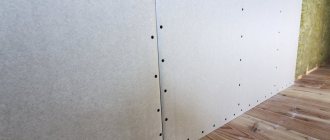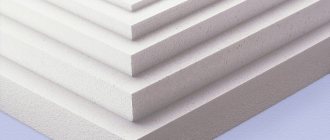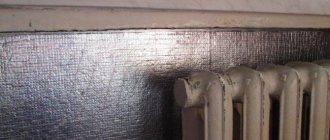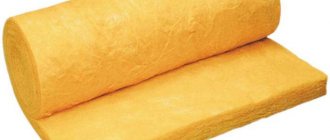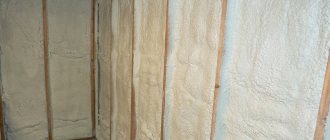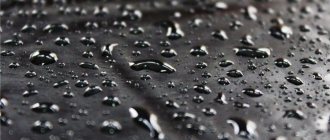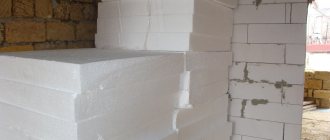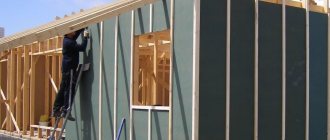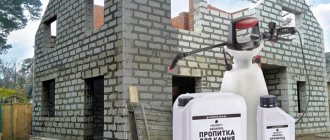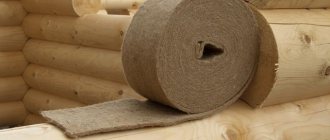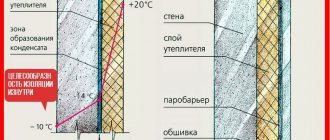Properties and characteristics of non-woven backing
Non-woven wallpaper is a non-woven, texture-free material with a base of long cellulose fibers. The top layer of the backing consists of polyester fibers. The function of the binding component is performed by acrylic polymer.
Thanks to the combination of all components, an unusually strong and reliable lining material is obtained, resistant to expansion and temperature influences.
Non-woven backing for wallpaper can replace the putty layer. Its uniqueness lies in its masking ability, which allows you to hide small irregularities or cracks.
It is worth noting that the material, like construction fiberglass web, reinforces microcracks. However, non-woven fabric is more elastic than gossamer, but this does not prevent it from maintaining its shape even with constant humidity.
Visually, the repair non-woven fabric resembles an ordinary Whatman paper. It is distinguished by a softer and more uniform structure.
Depending on the type of coating, construction interlining is distinguished:
- With non-woven covering;
- With fiberglass covering.
Non-woven backing for wallpaper costs from 900 to 10,000 rubles, has a width of 1.06 m, and the length can reach 25 and even 50 m.
This price range depends, firstly, on the length of the substrate, and, secondly, more expensive samples are covered with heavy-duty fiberglass, which increases the strength and density of the lining. Density indicators range from 160 g/m2.
Types of wallpaper substrate
The appearance depends on the wallpaper, and the strength and quality of the finish directly depends on the substrate. Each home will need a different type of material due to various factors. These are factors such as: who lives in the house, location, influence of natural conditions on the room, humidity and dampness. Therefore, let's look at the different types:
Foamed polyethylene
The first type of substrate for finishing walls in an apartment is a coating made of foamed polyethylene. There are different brands of substrates, Penolon, EcoHit and others. One of the types is Polyfoam for wallpaper. Distinctive features are high porosity, lightness, low thermal conductivity (approximately 0.028 W). Because of this indicator, the wallpaper backing can effectively contain the heat in the room.
Just one such layer of thermal insulation is equivalent to a half-brick wall.
Might be interesting
Thermal insulation
Distinctive features and variety of ceiling tiles…
Thermal insulation
Features and use of mineral wool
Noise insulation
How to soundproof a balcony roof yourself?
Noise insulation
Soundproofing sewer pipes in an apartment
Such sound insulation under wallpaper retains its qualities at temperatures from -60 to +90 degrees Celsius. This leveling material behaves well when glued to cold concrete walls that freeze easily and do not have acceptable thermal insulation.
Polyethylene wallpaper will greatly increase the comfort of living in such a house and reduce the cost of insulating it, replacing other well-known methods. Polyfom is also ideal for corner houses.
Soundproofing for wallpaper is produced and sold in rolls, like other types of insulation. The price is low, it costs one roll of lining, 14 meters long, and half a meter wide - about 1,300 rubles. 1m2 costs 185 rubles. Different brands cost different things.
Cork backing
The second type is a cork backing. It is quite popular for wall decoration due to the fact that it consists of natural material. It is environmentally friendly and safe, has good adhesion and high sound insulation. This is the kind of insulating material that is used when covering a recording studio.
If your main goal is to make the room as soundproof as possible, then this soundproofing underlay is ideal for this. Sharp and loud sounds, such as barking dogs or car horns, will not penetrate into a room decorated with cork. Of course, like any other underlayment, cork underlayment will not protect you from structural noise, such as the sounds of construction equipment, chiselling, drilling, etc.
Cork is an excellent insulator, the thermal conductivity coefficient is approximately 0.032-0.04 W, which is similar to that of foam plastic.
The disadvantages of this type are the fear of water plugs and high humidity. This material is hygroscopic, as a result of which it is not recommended to use cork insulation in rather damp rooms. One m2 will cost around 250 rubles.
Nonwoven
Non-woven fabric is the third type of wallpaper lining. This is a non-woven, modified cellulose material. A big plus of this solution is vapor permeability, which is why the walls are ventilated or ventilated. This helps remove moisture from the room. It has good adhesion to almost any surface, and the material has good water-repellent properties.
Due to the fact that the material is quite elastic, it compensates for any minor irregularities. Purchasing this insulation will cost from 500 rubles per roll.
The length is 11-12 meters, and the width is from 60 cm to a meter. Non-woven fabric is suitable for children's bedrooms and rooms where there are sick or elderly people, as it does not harm health.
Also, rigid structures such as drywall are often used for the substrate. But it, just like plywood, is susceptible to dampness. Space is required between the surface and the drywall for air circulation. If the room is suitable for this decoration, then this is an excellent solution that is ideal for wallpapering.
Advantages
Repair non-woven fabric is an excellent leveling base for wallpaper. At the same time, it can not only be covered with wallpaper, but also painted. The number of repaints can be up to seven times.
Due to the ability to mask minor surface defects, the stage of preliminary thorough preparation of the base can be skipped, which will speed up the repair process.
Non-woven backing can be a good contribution to an existing system of thermal and sound insulation of a room. Good density and integrity of the material ensure heat retention and noise reduction.
However, for the purpose of greater noise and heat insulation, it is better to give preference to substrates made of foamed polyethylene or cork samples.
The material is quite resistant to moisture. Along with this, it is vapor permeable, which, with periodic humidity, will help to avoid the formation of mold due to natural air exchange that occurs unhindered.
Painting non-woven fabric is extremely durable. It does not stretch when gluing and during use. Thanks to its strength, it occupies a leading position and displaces cheaper fiberglass mesh.
It is glued similarly to wallpaper, using glue for non-woven fabrics. Do not forget that it is necessary to coat the surface with glue, and not the non-woven material under the wallpaper. Before you begin finishing with wallpaper, it is advisable to wait several days until the lining is completely dry.
Environmental friendliness is the next advantage. Natural raw materials and unique production technologies guarantee the safety of the substrate.
It is impossible not to note the durability - construction non-woven fabric can be used for at least 25 years. This speaks not only of strength, but also of stability, as well as the resistance of the material to both temperature and mechanical influences.
Soundproofing under wallpaper from market leaders
The most well-known brands on the Russian market are Polifom, Polizol, Echokit, Penolon, Globex. These substrates from different manufacturers are made of polyethylene foam, covered on both sides with a layer of specially treated paper. Their thickness is usually 5 mm. They differ from each other in the density and degree of uniformity of the polyethylene layer, and the color of the paper layer. Available in rolls starting from 50 cm wide and varying in length.
Substrate from one of the main manufacturers
They can be used to insulate cold walls of premises from the inside - end walls of apartments, walls of country houses, concrete walls of utility and non-residential premises, including freezing and “crying” ones. In addition, they can be used where, for some reason, complex soundproofing structures that require special installation are not applicable. Thanks to their three-layer structure, they significantly (although, of course, not completely) reduce the level of sound transmitted into the room and are suitable for soundproofing internal walls, walls between the apartment and the entrance.
All these insulating bases are glued to the wall using strong adhesives designed for heavy wallpaper. It may take at least 72 hours to dry completely. Due to their considerable thickness, such substrates mask more significant wall defects than paper or non-woven substrates.
Related article: What do you need to know about fireproofing impregnation of wooden structures?
The underlay provides additional warmth and smooth walls
Some craftsmen who have experience working with multi-layer substrates recommend using fairly thick wallpaper with them; there is a risk that the joints of the substrate will be visible through thin wallpaper.
In addition, problems may arise with gluing vinyl wallpaper. They do not allow air to pass through, and therefore drying occurs through the joints. As a result, the wallpaper may come apart at the joints. To solve this problem, you can glue another base onto a three-layer backing, for example, non-woven, or prime the surface before gluing. This, of course, will complicate the process, but if there is a need for thermal insulation, it is better to go to the extra expense and effort.
The advantage of these base-substrates: the wallpaper can be removed from them and new ones can be glued. Disadvantage: Some of them are quite soft and can leave indentations in the wallpaper if pressed or hit.
Flaws
Among the shortcomings, formed according to consumer reviews, are:
- insufficient number of repaints;
- impossibility of applying putty.
However, both disadvantages are quite controversial. Seven repaintings of high-quality non-woven fabric already guarantee a 35-year service life, taking into account repainting every five years.
Regarding the application of putty, it is worth noting that the material was created to eliminate the need for subsequent putty, as is the case with fiberglass web. If the surface is not ideal enough, then it is rational to apply a putty layer under the lining.
Installation
Installation technologies for modern soundproofing materials vary depending on the material chosen.
Using dowel nails
Such a system is used in such materials as Phonestar GW. The panels are fastened using special dowel-nails, which are inserted into the designated holes in the panels. You need to drill holes in the wall in advance to connect it and the panels.
Detailed instructions for installing panels to soundproof a room.
Installation should begin from left to right and from bottom to top. Before installing the outer panel, its outer edges are cut off. The starting bar is installed close to the wall.
Applying plaster
Installing acoustic plaster yourself can cause many problems, as it requires certain skills. Beacons are pre-installed, which allow you to create a flat surface.
The plaster application process consists of three stages. The first step involves spraying a thick mixture as a base. The second stage involves filling the voids. The third is needed to consolidate the result.
Adhesive base
Such materials produced by SOFTBOARD are applied to a specially prepared adhesive base. Liquid nails intended for this purpose can be used as glue. Liquid nails are applied along the edges and in a couple of places in the center. First, the surface of the base is leveled using plaster.
The process of installing soundproofing material under wallpaper should not cause much difficulty, especially if you have certain skills. In order to get an excellent result at the end of the repair, you must fully comply with the installation technology:
- Preparing the wall surface. First you need to prepare the work surface where the material will be glued. To do this, it is necessary to eliminate defects in the form of large cracks. This is done using plaster, which is applied with a spatula; the surface is first primed. There should be no previous material left on the wall.
- Cutting strips. Soundproofing underlay for walls is sold in rolls over 10 meters long. Before gluing, it must be divided into strips equal to the height of the room. If possible, this should be done with a small margin, especially in the absence of practical skills, so that there is room for maneuver.
- Applying glue. Depending on the material used, the adhesive is applied to various surfaces; when using a non-woven backing, the adhesive is applied exclusively to the walls; polyurethane material requires additional application to the backing itself.
- Gluing strips. After applying the glue, you can proceed to gluing the strips. This must be done carefully to ensure neat joints. They should not stick out or puff up. Additionally, you can apply paper tape to the joints to obtain a better result.
- Drying. After completing the work, you need to let the glue dry. It is prohibited to perform any manipulations with the substrate within 72 hours. Only after the expiration of the period can the finishing work begin.
Modern soundproofing materials make a person’s life much more comfortable, eliminating extraneous noise, which can cause significant harm to his health. However, installation of the material also has its drawbacks, but they are compensated by a large number of positive aspects. It is up to everyone to decide whether to use it or not.
In the video you will see the process of sound and noise insulation of walls, and will also tell you what materials are needed and their cost.
Material selection
Non-woven wallpaper is a material that requires special attention when choosing. After all, not only aesthetics, but also practicality and durability of the finish depend on its quality.
Several criteria can be identified, based on which it is advisable to choose a high-quality construction non-woven fabric:
- Structure. Non-woven lining is known for its uniform and silky texture. Therefore, if any foreign inclusions, inhomogeneities or other visually noticeable defects are detected, it is better to refuse the purchase. Flaws on the surface indicate unfair production or a violation of the technological process.
- Edges of the substrate. Good manufacturers pay great attention to the quality of edge processing. They must be perfectly smooth and solid. Tears or loose edges can not only deteriorate the appearance of the decorative surface, but also lead to a decrease in the overall service life.
- Elasticity. Painting non-woven fabric should be resilient, despite its elasticity. The ability of the lining to withstand mechanical stress and return to its shape depends on its elasticity. When purchasing, you should pay attention to the presence of dents or bends on the roll. The highest grade substrate is not characterized by their presence.
- Strength. You can determine it by pulling a section of non-woven fabric in different directions. If it is even slightly stretched, this indicates insufficient strength. High-quality material is not subject to stretching.
- Compound. The non-woven base is subject to mandatory certification. Therefore, when purchasing a lining, you must ask the seller for quality certificates for the products. There should not be any chemical impurities in the composition.
To be sure of quality, it is better to give preference to products from already established brands.
Non-woven backing for wallpaper is a unique durable material that can restore its shape. Resistance to various influences makes it one of the most practical types of substrates - strong, reliable and durable.
Cork base
Another type of insulation for wallpaper is cork. This excellent material is also used as a decorative coating, but due to its low thermal conductivity and ability to absorb noise, it can also be used for soundproofing and thermal insulation of rooms. It is very environmentally friendly, as it allows air to pass through and allows the walls to “breathe”. For a greater insulating effect, it is better to use not one, even thick, layer of cork, but several thin ones.
Cork backing insulates walls well
Not decorative, but technical cork is used as a base for wallpaper. It requires special types of glue, and it must be primed before sticking.
Before starting work, be sure to read the instructions - different bases may have different features and rules of use. Some materials, for example, must be laid out unfolded. Others require priming the wall or applying adhesive to the wall rather than the canvas. The choice of glue also depends on the type of substrate. However, there are basic rules common to all work of this nature:
- The surface to be pasted should be carefully prepared. Even if the material can be glued to surfaces with defects, only minor cracks and roughness are implied. The walls must be clean.
- The temperature in the room where the work is carried out should not be lower than 10 degrees Celsius. Humidity should not exceed 70%.
- There should be no drafts in the room.
- Do not glue the base substrate onto a frozen or damp wall. Such walls are pasted over in the warm season.
- All substrates are glued end to end. You can glue thin paper with an overlap, and only if you are sure that the overlap strips will not be visible under the wallpaper.
- Before gluing wallpaper, you must wait until the base is completely dry.
- The wallpaper must be glued to the base so that the joints of the base and wallpaper do not coincide.
Related article: Sample application for balcony repair
Useful video on how to properly stick the backing:
The best posts
- 4x4 ATV based on OKI
- How to get bedbugs out of a sofa yourself using folk remedies
- Choosing a mirror for the hallway: tips for decorating and increasing space (50 photos)
- Automation of electric valve drive
- DIY artificial snow
- Stained glass in interior doors: elegance and practicality in sophistication
- Do-it-yourself Ikebana “Winter” from natural material with photo
- What you need to know when creating a kitchen-living room design
What is soundproofing wallpaper for an apartment?
There are certain wall coverings (wallpaper backing) that were developed taking into account all the wishes of experienced craftsmen and ordinary consumers. This soundproofing surface is made of polyethylene (foam), which is covered on both sides with special paper. In addition to the paper surface, the backing can be cork or non-woven.
The main advantages of such surface coating are sound insulation and thermal insulation.
In addition, this material is well suited for any type of wallpaper. That is, such material will allow you to quickly and efficiently decorate walls.
Wallpaper backing is an excellent material that has a high level of sound insulation and is also a thermal insulation coating
Main advantages:
- Characterized by its high strength, you don’t have to worry about it breaking easily.
- Thanks to the use of environmentally friendly materials for production, it is perfect for any home.
- This special surface does not absorb moisture, but rather helps prevent condensation.
- The sound insulation of this wallpaper helps to achieve comfort and a calm environment.
This roll surface is an excellent material on which to stick the selected wallpaper. Moreover, manufacturers of such substrates have achieved excellent production results. This surface does not lose its properties for many years, which allows you to wallpaper the walls several times.
The wallpaper underlay will prevent the appearance of fungus on the walls for decades, prevent the formation of condensation and provide excellent sound insulation. And besides this, it is ideal for leveling uneven surfaces.
The option of wall insulation using a substrate is the most optimal in terms of price, reliability and ease of installation
The main producers today are:
- Ecohit . The material consists of polyethylene foam and has a white paper covering. Thanks to mechanical production, Ecoheat has a more uniform and dense structure.
- Penolon . This cross-linked polyethylene foam is very popular today.
- Polyphus (trocellen) . Thermal insulation is the most undeniable advantage of these wall coverings. These materials stand out for their high quality as well as ease of use.
Characteristics and reviews of masters
All craftsmen involved in finishing and decorating walls very carefully select materials for repairs. This is not surprising, because the length of use of wall coverings depends on the quality of materials.
Therefore, reviews from experienced professionals describe the advantages of using special wallpaper substrates, as well as their disadvantages:
- Such coatings are not suitable for rooms with high humidity.
- Be sure to treat the surface of the wall if there is even the slightest manifestation of fungus.
- Wallpaper that is too thin can show through the hidden backing, so it is better to choose a thicker material for covering walls.
- Wallpaper underlay cannot completely soundproof a room. Even the most expensive types cannot guarantee this. However, due to its reasonable cost, it is possible to achieve a good result, and noise insulation will become possible.
- The material is very convenient to use, cuts well and thanks to the paper surface the sheet can be easily glued.
- The substrate is distinguished by its environmental safety, has no odors, and does not emit dust. That is, it can be used to decorate walls in any room.
- Such coatings have received excellent reviews due to their ability to increase heat-shielding properties. Therefore, such insulation is indispensable for finishing walls in block houses and dachas.
Wallpaper with a backing will retain its original appearance longer, the walls will look smoother
Whatever substrate is chosen, everyone will be able to appreciate its structural stability. This will allow you to quickly and efficiently level any wall and create an ideal surface for wallpapering.
Thanks to the ease of use of this material, you can quickly achieve excellent results. And you don’t have to be a professional to do this.
